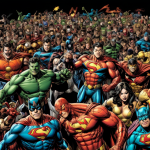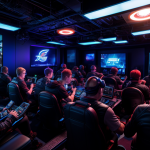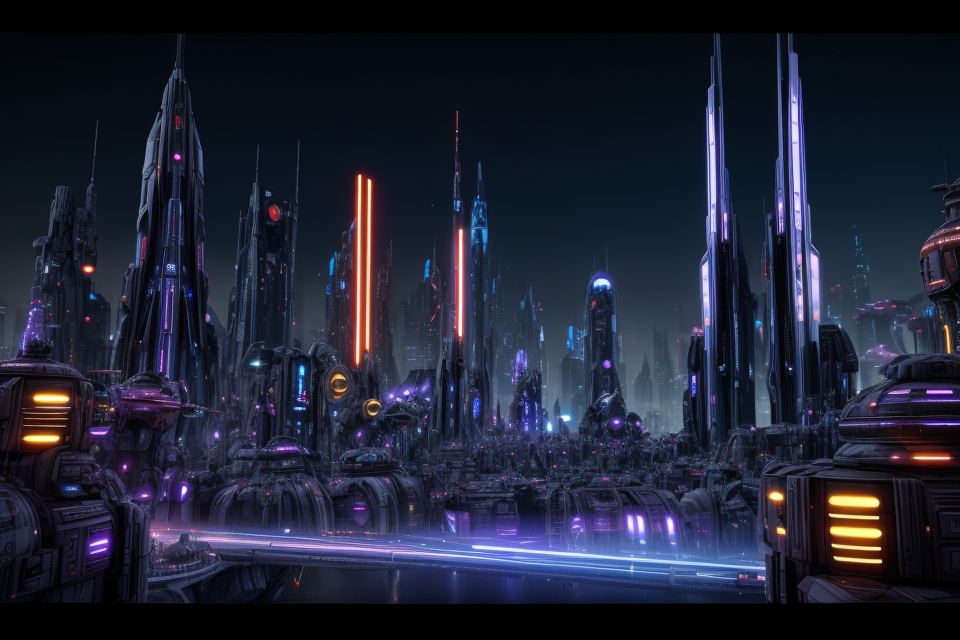Star Wars, the iconic science fiction franchise, has captivated audiences for decades with its epic space battles, larger-than-life characters, and thrilling adventures. But what category does this intergalactic saga fall under? Is it simply science fiction, or is there more to it than meets the eye? In this comprehensive analysis, we will explore the various themes and elements that make Star Wars a unique and unforgettable phenomenon, and determine its rightful place in the world of popular culture. So, buckle up and join us on this journey to the galaxy far, far away, as we delve into the category that Star Wars falls under.
Star Wars falls under the category of science fiction and fantasy. It is a fictional universe created by George Lucas that features a mix of technology, magic, and mythology. The story follows the adventures of various characters, including humans, aliens, and droids, as they navigate the galaxy and battle against evil forces. The franchise includes movies, television shows, books, and other media, and has become a cultural phenomenon with a dedicated fan base.
Is Star Wars a science fiction movie?
Examining the sci-fi elements in Star Wars
Star Wars is often categorized as a science fiction movie due to its futuristic setting, advanced technology, and space exploration. In this section, we will examine the sci-fi elements present in the Star Wars universe.
The use of futuristic technology
One of the most prominent sci-fi elements in Star Wars is the use of futuristic technology. The movie features advanced spacecrafts, laser swords, holograms, and other high-tech gadgets that are not yet available in our current time. These technologies play a crucial role in the plot and help to create a believable sci-fi world.
Space exploration and travel
Another sci-fi element present in Star Wars is space exploration and travel. The movie takes place in a galaxy far, far away, and features various planets, space stations, and other celestial bodies. The characters travel across the galaxy using starships, which are equipped with hyperdrives that allow them to travel faster than the speed of light. This element of space exploration and travel is a classic characteristic of science fiction movies.
The Force and magical powers
The Star Wars universe also features a unique element called “The Force,” which is a mysterious energy field that is wielded by certain characters in the movie. The Force allows these characters to perform supernatural feats, such as levitating objects, controlling minds, and sensing the future. This element of magical powers is another classic characteristic of science fiction movies.
Advanced artificial intelligence
In addition to these elements, Star Wars also features advanced artificial intelligence in the form of droids. Droids are robots that are capable of thought and action, and they play a significant role in the plot of the movie. They are programmed to serve their masters, but some droids develop their own personalities and motivations, which adds an interesting dynamic to the story.
Overall, the sci-fi elements in Star Wars are numerous and diverse, ranging from advanced technology to space exploration and travel, to magical powers and artificial intelligence. These elements are what make Star Wars a classic science fiction movie.
The futuristic technology and world-building in Star Wars
Star Wars is often considered a science fiction movie due to its futuristic technology and world-building. The franchise is known for its advanced technology and gadgets, such as spaceships, laser swords, and droids. These technologies are depicted as existing in a distant future, which allows the filmmakers to explore the possibilities of what technology could be like in the future.
The world-building in Star Wars is also impressive. The galaxy depicted in the films is vast and intricate, with different planets, cultures, and species. The filmmakers have created their own unique language, the Galactic Basic, which is spoken by characters in the film. This attention to detail adds to the believability of the world and makes it feel like a real place.
The futuristic technology and world-building in Star Wars also play a significant role in the plot of the films. The technology used by the characters often drives the action and helps to move the story forward. For example, the spaceships used by the Rebel Alliance are crucial to their mission to defeat the Empire. The droids, such as R2-D2 and C-3PO, also play a vital role in the story, as they are often used to carry important information and help the characters to escape danger.
Overall, the futuristic technology and world-building in Star Wars are essential elements of the franchise that help to create its unique and immersive universe. They allow the filmmakers to explore the possibilities of what technology and society could be like in the future, while also driving the plot and adding to the believability of the world.
Is Star Wars a fantasy movie?
The magical elements in Star Wars
Star Wars is often considered a fantasy movie due to its magical elements. These elements include:
- The Force: a mysterious energy field that is wielded by certain individuals, known as Jedi and Sith. The Force allows its users to perform supernatural feats, such as levitating objects and projecting themselves across great distances.
- The Jedi and Sith: the two main groups of characters in the Star Wars universe, each with their own unique abilities and beliefs. The Jedi are often depicted as noble and virtuous, while the Sith are depicted as evil and power-hungry.
- The various creatures and aliens: the Star Wars universe is home to a vast array of creatures and aliens, many of which possess unique abilities and characteristics. Examples include the Wookiees, who are known for their strength and loyalty, and the Ewoks, who are small, cute creatures with a penchant for mischief.
- The magical weapons: many of the weapons used in Star Wars have magical properties, such as the lightsaber, which is a weapon that is powered by the Force and can cut through almost any material.
Overall, the magical elements in Star Wars play a significant role in shaping the world and its characters, and contribute to the overall fantastical feel of the series.
The mythical creatures and characters in Star Wars
Star Wars is renowned for its mythical creatures and characters that inhabit its rich universe. These characters and creatures play a crucial role in the Star Wars story, adding depth and intrigue to the overall narrative. In this section, we will explore the various mythical creatures and characters in Star Wars and examine their significance in the story.
One of the most iconic mythical creatures in Star Wars is the Chewbacca. Chewbacca, also known as Chewie, is a Wookiee and the loyal companion of Han Solo. With his distinctive growls and roars, Chewbacca is instantly recognizable and has become a fan favorite. He is not only a powerful fighter but also a loyal friend, which makes him an essential character in the Star Wars universe.
Another mythical creature in Star Wars is the Jedi. The Jedi are a group of powerful warriors who use the Force to protect the galaxy from the dark side. They are often depicted wielding lightsabers, which are iconic weapons that emit a blue or green energy blade. The Jedi are central to the Star Wars story, and their actions and decisions have a significant impact on the overall narrative.
The Sith are another group of mythical creatures in Star Wars. The Sith are a dark order of Force users who seek power and control. They are often depicted as ruthless and cunning, and their actions often conflict with the Jedi. The Sith are a crucial element of the Star Wars universe, and their presence adds depth and complexity to the story.
In addition to these mythical creatures, Star Wars also features a variety of other characters, including humans, aliens, and droids. These characters are essential to the story and contribute to the rich tapestry of the Star Wars universe. From the brave and determined Luke Skywalker to the wise and powerful Yoda, each character plays a vital role in the Star Wars story.
Overall, the mythical creatures and characters in Star Wars are an essential part of the story. They add depth and complexity to the narrative, and their actions and decisions have a significant impact on the overall plot. Whether you are a fan of the iconic Chewbacca or the powerful Jedi, there is no denying that the mythical creatures and characters in Star Wars are an integral part of what makes this franchise so beloved by audiences around the world.
Is Star Wars a drama movie?
The exploration of human emotions in Star Wars
Star Wars is often considered a science fiction movie, but it also contains elements of drama. The exploration of human emotions is one aspect of the movie that contributes to its dramatic nature. In this section, we will examine how Star Wars explores human emotions and how this contributes to the movie’s overall dramatic effect.
One of the most prominent emotions explored in Star Wars is love. The relationship between Anakin Skywalker and Padmé Amidala serves as a central love story throughout the prequels. Their love is tested by their duty to the Jedi Order and the Republic, ultimately leading to the downfall of Anakin and the rise of Darth Vader. The exploration of this love story adds depth to the characters and highlights the consequences of their actions.
Another emotion explored in Star Wars is fear. The villainous characters, such as Darth Vader and the Emperor, embody fear. Their power and control instill fear in others, which drives the plot forward. The fear of failure or loss also motivates some of the main characters, such as Han Solo and Luke Skywalker, to take action and fight against the Empire.
The exploration of love and fear in Star Wars serves to create a relatable and emotional experience for the audience. The characters’ emotions drive the plot, creating a dramatic tension that keeps the audience engaged. Additionally, the exploration of these emotions highlights the humanity of the characters, even those who are not human, such as droids and aliens. This humanization adds to the overall dramatic effect of the movie.
Overall, the exploration of human emotions in Star Wars contributes to its dramatic nature. The love story between Anakin and Padmé, the fear instilled by the villains, and the emotional journeys of the main characters all serve to create a relatable and engaging experience for the audience. By incorporating these emotional elements, Star Wars transcends its science fiction genre and becomes a classic drama that continues to captivate audiences of all ages.
The relationships and conflicts between characters in Star Wars
Star Wars is a cinematic universe that has captivated audiences for decades with its epic storytelling, stunning visuals, and memorable characters. One of the key aspects of the Star Wars franchise is the relationships and conflicts between its characters. These relationships and conflicts are central to the plot of each film and serve to drive the story forward.
One of the most iconic relationships in the Star Wars universe is that between Luke Skywalker and Princess Leia Organa. Their dynamic is a classic example of a hero and his mentor, with Leia guiding Luke on his journey to become a Jedi Knight. Another significant relationship is that between Han Solo and Chewbacca, whose bond is rooted in friendship and loyalty.
In addition to these relationships, the Star Wars franchise is also known for its conflicts. The ongoing battle between the Rebel Alliance and the Galactic Empire serves as the backdrop for much of the series, with each film focusing on different characters and their struggles within this larger conflict. The conflict between the light and dark sides of the Force is another central theme of the Star Wars universe, with characters like Anakin Skywalker and Darth Vader embodying this struggle.
The relationships and conflicts between characters in Star Wars are not only integral to the plot but also serve to deepen the audience’s emotional connection to the story. By exploring the complexities of human (and non-human) relationships and the tensions that arise from conflict, the Star Wars franchise has become a beloved part of popular culture.
Is Star Wars an action movie?
The thrilling space battles and fight scenes in Star Wars
The Star Wars franchise is renowned for its thrilling space battles and fight scenes, which have become synonymous with the action genre. These sequences are carefully choreographed and executed, with special effects that immerse the viewer in the fictional universe.
In Star Wars, space battles are portrayed as grand-scale conflicts between powerful ships, with laser beams and explosions filling the screen. These battles are not just mere visual spectacles, but they also serve a purpose in advancing the plot and character development. For instance, the Battle of Yavin in the original Star Wars film (1977) is a pivotal moment in the protagonist’s journey, as they successfully destroy the Death Star, a massive, planet-destroying weapon.
Fight scenes in Star Wars are equally engaging, with characters using a variety of weapons and techniques to engage in hand-to-hand combat. Iconic characters like Luke Skywalker and Darth Vader have memorable fight scenes that showcase their unique fighting styles and abilities. These scenes often take place in visually striking environments, such as the swamps of Dagobah or the snowy wasteland of Hoth, adding to the overall immersion of the viewer.
Overall, the thrilling space battles and fight scenes in Star Wars are a significant contributor to the franchise’s status as an action movie. They are expertly crafted and serve to advance the plot and character development, making them a key element of the Star Wars experience.
The use of physical stunts and practical effects in Star Wars
In the realm of cinematic storytelling, the Star Wars franchise has become a cultural phenomenon that has transcended genres. Although it is often classified as an action movie, its scope and depth encompass various elements that defy simple categorization. However, one aspect that remains central to the Star Wars experience is the use of physical stunts and practical effects.
- Physical Stunts:
- In contrast to the prevailing trend of relying on computer-generated imagery (CGI) for action sequences, the Star Wars franchise has always prioritized the use of practical effects. This approach has enabled the filmmakers to create visceral and tangible action scenes that engage the audience on a more visceral level.
- The franchise’s commitment to practical effects is evident in the extensive use of physical stunts. Instead of relying on stunt doubles or CGI, the actors themselves often perform their own stunts, adding a sense of authenticity and vulnerability to their performances.
- This approach is exemplified by iconic moments such as Harrison Ford’s harrowing escape from the Death Star in the original Star Wars film, where he piloted his X-Wing fighter through a narrow chasm, narrowly evading enemy fire.
- Practical Effects:
- Another aspect that sets Star Wars apart from other action movies is its use of practical effects. From the creation of iconic characters like Darth Vader and Chewbacca to the construction of massive sets and intricate props, the franchise has always placed a premium on physical craftsmanship.
- This dedication to practical effects has allowed the filmmakers to create a rich and immersive world that feels tangible and believable. For instance, the filmmakers employed a combination of miniatures and matte paintings to create the breathtaking landscapes of Tatooine and Hoth, rather than relying on CGI to generate these environments.
- Furthermore, the use of practical effects has enabled the filmmakers to achieve a sense of continuity and coherence across the franchise. This consistency in the visual language of the Star Wars universe has been crucial in establishing a shared universe that spans multiple films, television shows, and novels.
In conclusion, the use of physical stunts and practical effects in Star Wars plays a crucial role in shaping the franchise’s identity as an action movie. By prioritizing these elements, the filmmakers have created a unique cinematic experience that engages the audience on multiple levels and transcends the boundaries of traditional genre classifications.
Is Star Wars a historical movie?
The inspiration behind the creation of Star Wars
George Lucas, the creator of Star Wars, was heavily influenced by the works of Akira Kurosawa, a renowned Japanese filmmaker. In particular, Lucas drew inspiration from Kurosawa’s 1958 film, The Hidden Fortress, which tells the story of two bounty hunters who protect a princess as they navigate a civil war in feudal Japan.
Lucas was also inspired by the idea of the “hero’s journey,” a narrative structure that was popularized by Joseph Campbell in his book, The Hero with a Thousand Faces. This structure follows a hero who embarks on a quest, faces challenges, and ultimately achieves a great deed. Lucas incorporated this structure into the story of Star Wars, with Luke Skywalker serving as the hero and Darth Vader as the villain.
Additionally, Lucas was influenced by the space opera genre, which features grand, sweeping stories set in space. He sought to create a modern version of this genre, using cutting-edge special effects and a diverse cast of characters.
Overall, the inspiration behind the creation of Star Wars was a blend of historical and cultural influences, as well as a desire to create a new kind of epic science fiction story.
Is Star Wars a musical?
The iconic soundtrack and music in Star Wars
The Star Wars franchise is renowned for its groundbreaking visual effects, compelling storytelling, and unforgettable characters. However, one aspect that has contributed significantly to the enduring popularity of the series is its music. The iconic soundtrack and music in Star Wars have become synonymous with the franchise and have played a vital role in shaping its distinctive atmosphere and identity.
The Star Wars soundtrack was composed by John Williams, a legendary composer known for his work on numerous iconic film scores, including Jaws, E.T. the Extra-Terrestrial, and Indiana Jones. Williams’ score for Star Wars is considered one of his greatest achievements and has been widely acclaimed for its emotional depth, thematic richness, and memorable melodies.
The music in Star Wars serves multiple purposes. It underscores key dramatic moments, conveys the mood and tone of a scene, and establishes a sense of continuity and familiarity across the series. The iconic main theme, also known as the “Star Wars theme,” has become one of the most recognizable and enduring musical motifs in cinema history. It has been featured in every Star Wars film and has been adapted and remixed in various forms, from orchestral arrangements to electronic remixes.
In addition to the main theme, the Star Wars soundtrack features a variety of distinct musical motifs and leitmotifs that are associated with specific characters, locations, or story elements. For example, the “Imperial March” is a memorable melody that is played whenever the Imperial forces or the villainous Darth Vader appear on screen. Similarly, the “Luke’s Theme” is a recurring motif that represents the journey and development of the protagonist, Luke Skywalker.
The music in Star Wars is not only a vital storytelling tool but also a cultural phenomenon in its own right. The soundtracks for each Star Wars film have been released as standalone albums and have sold millions of copies worldwide. The music has also been performed live in concert halls around the world, with many of these performances featuring full orchestral arrangements and guest soloists.
In conclusion, the iconic soundtrack and music in Star Wars play a crucial role in shaping the franchise’s identity and atmosphere. They have become an integral part of the Star Wars experience and have contributed significantly to the series’ enduring popularity and cultural impact.
The role of music in enhancing the emotional impact of Star Wars
Music has always played a significant role in the Star Wars franchise. From the iconic opening notes of the main theme to the scores that accompany each film’s most pivotal moments, the music in Star Wars is designed to enhance the emotional impact of the story. In this section, we will explore the various ways in which the music in Star Wars contributes to the franchise’s enduring appeal.
The use of leitmotifs
One of the most notable aspects of the music in Star Wars is the use of leitmotifs. A leitmotif is a recurring musical theme that is associated with a particular character, object, or idea. In Star Wars, leitmotifs are used to underscore important themes and motifs throughout the franchise. For example, the “Imperial March” is a leitmotif that is associated with the Galactic Empire and its agents, such as Darth Vader. The use of leitmotifs helps to reinforce the emotional significance of key elements of the story and helps to create a sense of continuity across the different films and media in the franchise.
The use of sound effects
In addition to the use of leitmotifs, the sound effects in Star Wars also play a significant role in enhancing the emotional impact of the story. From the iconic “bzzzt” sound of a blaster to the roar of a spaceship, the sound effects in Star Wars are carefully crafted to create a sense of immersion in the fictional universe. The use of sound effects helps to reinforce the emotional significance of key moments in the story and helps to create a sense of realism that draws the viewer into the world of Star Wars.
The use of voice acting
Finally, the use of voice acting in Star Wars also plays a significant role in enhancing the emotional impact of the story. From the deep, ominous tones of James Earl Jones as Moff Tarkin to the cheerful optimism of Mark Hamill as Luke Skywalker, the voice acting in Star Wars is carefully crafted to bring the characters to life and to reinforce their emotional significance in the story. The use of voice acting helps to create a sense of emotional connection between the viewer and the characters, which is a key factor in the enduring appeal of the franchise.
Overall, the music, sound effects, and voice acting in Star Wars all play a significant role in enhancing the emotional impact of the story. By carefully crafting these elements, the franchise is able to create a sense of immersion and emotional connection that has helped to make it one of the most enduring and beloved franchises in popular culture.
The complex and multifaceted nature of Star Wars
- The Science Fiction genre:
- The space opera subgenre: Star Wars is a classic example of a space opera, a subgenre of science fiction that focuses on epic adventures in outer space. Space operas often involve larger-than-life characters, dramatic conflicts, and grand, sweeping themes. Star Wars incorporates all of these elements, making it a prime example of the space opera subgenre.
- The mythological influence: George Lucas drew heavily from mythology and religion for the creation of the Star Wars universe. The Force, for example, is heavily influenced by Eastern mysticism and the concept of the Tao. The characters of Yoda and Obi-Wan Kenobi are also reminiscent of ancient wisdom figures from mythology. This rich mythological foundation adds depth and complexity to the Star Wars universe, setting it apart from other science fiction works.
- The Fantasy genre:
- The hero’s journey: The Star Wars saga follows the classic hero’s journey, a narrative structure common in fantasy literature. The hero, in this case, Luke Skywalker, is called to adventure, faces challenges and trials, and ultimately achieves victory over the evil empire. This narrative structure gives the Star Wars story a strong fantasy element, connecting it to the genre of epic fantasy.
- The magical realm: The Star Wars universe also contains magical elements, such as the Force, Jedi mind tricks, and the lightsaber. These magical elements are integral to the story and contribute to the fantasy feel of the series.
- The Adventure genre:
- The epic quest: The Star Wars saga is an epic quest, with the hero embarking on a dangerous journey to save the galaxy from the evil empire. This is a common trope in the adventure genre, which emphasizes action, danger, and excitement.
- The heroic characters: The characters of Star Wars, particularly Luke Skywalker and Han Solo, are archetypal heroes of the adventure genre. They are brave, resourceful, and willing to take risks to achieve their goals. This heroic element is essential to the adventure genre and is present in abundance in Star Wars.
- The Drama genre:
- The complex characters: The characters of Star Wars are complex and multifaceted, with deep backstories and intricate motivations. For example, Darth Vader’s fall to the dark side and his relationship with his son, Luke Skywalker, provide a rich emotional landscape for the story. This complexity of character is a hallmark of the drama genre, which focuses on the internal struggles and conflicts of its characters.
- The moral ambiguity: The Star Wars universe is full of moral ambiguity, with characters who are neither wholly good nor wholly evil. For example, Han Solo is a rogue who often works against the law, but he also has a strong sense of loyalty and justice. This moral ambiguity adds depth to the story and creates tension, making it a key element of the drama genre.
Overall, the complex and multifaceted nature of Star Wars makes it difficult to categorize it under a single genre. It draws from science fiction, fantasy, adventure, and drama, making it a unique and unparalleled work of cinematic art.
The enduring popularity and cultural impact of Star Wars
Since its debut in 1977, Star Wars has become a cultural phenomenon, captivating audiences around the world with its imaginative storytelling, groundbreaking special effects, and iconic characters. The film’s enduring popularity can be attributed to several factors, including its timeless themes, memorable music, and innovative use of technology.
One of the key reasons for Star Wars’ continued success is its ability to resonate with audiences of all ages. The film’s themes of good versus evil, friendship, and sacrifice are universal and timeless, striking a chord with viewers across generations. The character of Luke Skywalker, in particular, has become a symbol of hope and courage for many, inspiring countless fans to embrace their own heroic qualities.
Another factor contributing to Star Wars’ cultural impact is its iconic music. John Williams’ score is instantly recognizable and has become synonymous with the franchise. The memorable themes and melodies have transcended the boundaries of the film itself, becoming a cultural touchstone that evokes strong emotions and associations for many. The Star Wars theme, in particular, has become a cultural icon, representing the essence of adventure and exploration.
Furthermore, Star Wars has been instrumental in shaping the landscape of science fiction and fantasy in popular culture. The film’s groundbreaking special effects and innovative use of technology have influenced countless films and television shows, pushing the boundaries of what is possible in storytelling. The franchise has also spawned a vast array of merchandise, from action figures and toys to books, video games, and theme park attractions, further solidifying its position as a cultural phenomenon.
In conclusion, the enduring popularity and cultural impact of Star Wars can be attributed to its timeless themes, memorable music, and innovative use of technology. The franchise has transcended the boundaries of film, becoming a cultural touchstone that continues to inspire and captivate audiences around the world.
FAQs
1. What is Star Wars?
Star Wars is a popular science fiction movie franchise created by George Lucas. It began in 1977 with the release of the first film, “Star Wars: Episode IV – A New Hope,” and has since become a cultural phenomenon with a global fan base. The franchise includes movies, television series, novels, comics, and other media.
2. What are the different categories that Star Wars falls under?
Star Wars falls under several categories, including science fiction, fantasy, adventure, and drama. It combines elements of science fiction, such as space travel and advanced technology, with fantasy elements, such as magic and mythical creatures. The franchise also includes action, adventure, and drama, as it follows the struggles of characters in a galaxy-spanning conflict.
3. Is Star Wars considered a space opera?
Yes, Star Wars is often considered a space opera. Space opera is a subgenre of science fiction that typically involves grand, sweeping stories set in space, with epic battles, larger-than-life characters, and high drama. Star Wars fits this description, with its sprawling narrative, epic battles, and iconic characters.
4. Is Star Wars considered a myth?
While Star Wars is not considered a myth in the traditional sense, it does draw inspiration from mythology and incorporates many mythological elements into its storytelling. The franchise features mythical creatures, such as the Jedi and the Sith, and incorporates themes and motifs from ancient myths and legends.
5. What makes Star Wars unique?
Star Wars is unique in its combination of science fiction and fantasy elements, as well as its iconic characters, such as Luke Skywalker, Princess Leia, and Darth Vader. The franchise has also been influential in popular culture, inspiring numerous imitators and spin-offs in the science fiction and fantasy genres. Additionally, the franchise has been recognized for its innovative use of special effects and groundbreaking filmmaking techniques.









